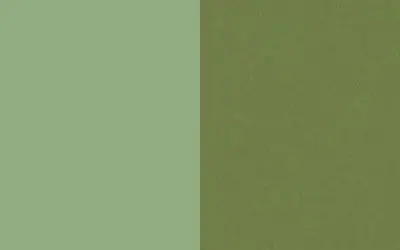Sage and olive green are among the most popular shades of green. They are among the best green accent colors.
But they’re not the same. Sage is a darker green shade, while olive green is brighter.
Also, each is made differently. Whereas sage is a combination of green and gray in various proportions, olive green has a high concentration of yellow.
In this guide, I explore the difference between the two green paint colors and explain how to pick the right shade for your next project.
Sage Green vs Olive Green: What’s the Difference?
The main difference between sage and olive green is contrast. Sage is a darker shade of green compared to olive. Indeed, the easiest way to make sage is by adding drops of gray to color wheel green until you attain the desired hue. Meanwhile, to make olive green, mix one part of blue paint with three parts yellow to make the base green. Then add drops of red to achieve olive green.
What is Sage Green?

Sage is a deep green paint color with blue undertones. It gets its name from the dried leaves of the sage plant, a pale green herb native to the Mediterranean region.
Sage falls in the green spectrum but is significantly subdued and muted. Gray hues accompany the blue undertones giving it an earthly feel.
Sage color properties
With its subtle and calming properties, sage is a popular choice for creative applications. So, what acrylic colors make sage green?
You can achieve the desired shade by combining green and gray using various color mixing methods.
However, a quicker approach involves blending basic green and gray together, as the sage color (#B2AC88) combines green and gray.
It’s highly versatile and thus pairs well with multiple colors on the color wheel. For instance, sage green combines exceptionally with white, creating a fresh atmosphere.
I also use it alongside gray to create a peaceful and relaxing feeling. Alternatively, combine sage with navy to add depth and contrast. It also works well with gold and coral.
But if you seek sage green replacements, some of the best alternatives are other muted shades of green.
Chartreuse and pistachio are excellent choices. Alternatively, consider muted shades of purple such as periwinkle and lavender.
Common applications of sage green
Sage green is popular in interior design, fashion, and events. For instance, it brings a sense of balance and harmony to interior design.
Sage green also makes rooms appear larger. Therefore, it’s ideal for a small space. It adds depth and occasionally introduces a hint of drama alongside bolder colors.
Benjamin Moore Saybrook Sage and Sherwin Williams Liveable Green are the best examples of sage green.
What is Olive Green?

Named after the color of ripe olive skins, olive is a green shade incorporating yellow and gray undertones.
Its deep hue often leads to confusion with pale brown, yet olive remains distinct and unique within the yellow and gray color palette.
Instead, olive green lies between yellow and green on the color wheel. Also, it’s not the same as olive drab.
“Drab” colors are light brown colors created from undyed homespun wool. Thus, “olive drab” (#6B8E23) refers to brownish-green colors. Olive green is slightly different.
Olive green properties
Olive green (hex code #BAB86C) contains 72.9% red, 72.2% green, and 42.4% blue when using the RGC color scheme.
Meanwhile, it comprises 0% cyan, 1% magenta, 42% yellow, and 27% black when working within the CMYK color space.
The easiest way to make olive green paint is by mixing basic green with a few drops of red paint.
Combine one part of blue paint with three parts of yellow to form basic green.
Then add a touch of red for a deeper green hue. A few drops are sufficient, as too much red aint creates a muddy brown color.
Olive green pairs best with neutrals like white, beige, and gray. However, you can also use it alongside colors from the opposite side of the color wheel, including purples, violets, and red.
Common applications of olive green
Olive green has many uses dating back to the 12th century. But it became more prominent around World War One when the US Army adopted olive green for their troops, weapons, and tanks.
However, the “woodland” pattern later replaced it in 1981. Besides combat, olive green is popular in fashion and interior design. It brings a sense of growth, renewal, and rebirth.
Sage Green vs Olive Green: Head-to-Head
Hopefully, you’ve gathered enough from the discussion to make the right choice. If not, the following head-to-head comparison simplifies everything.

Sage vs Olive green: definition
Sage green is a muted green shade with strong gray undertones, though it also includes a significant amount of blue.
It gets its name from dried sage leaves. Meanwhile, olive green is a more yellowish shade of green.
It’s named after the color of ripened olive fruits. Sage and olive are available in many different shades.
Sage vs Olive green: technical specs and Hex codes
Sage green (#B2AC88) is a blue-gray shade of green comprising 69.8% red, 67.5% green, and 53.3% blue on the RGB color space.
Alternatively, it comprises 0% cyan, 3% magenta, 24% yellow, and 30% black on the CMYK color chart.
Meanwhile, olive green (#BAB86C) is a yellow-heavy shade of green. It comprises 72.9% red, 72.2% green, and 42.4% blue on the RGB color chart.
It comprises 0% cyan, 1% magenta, 42% yellow, and 27% black if working within the CMYK color space.
Sage vs Olive Green: Meaning and Symbolism
Sage and olive green are closely associated. Thus they mean almost the same things in most societies.
For instance, many societies often associate sage green with wisdom and sound judgment.
It also communicates peace and growth and is associated with nature and ecology.
Similarly, olive green is associated with wisdom, growth, and nature. However, the olive color may symbolize harmony, hope, and compassion in some cultures.
Sage green vs Olive green: how to mix each
Making sage green is a little different from olive green.
From my experience, making sage green involves mixing two parts yellow with one part blue to make the base green and adding a dash of red.
You may add small amounts of white and black to adjust the shade.
Meanwhile, to make olive green, mix three parts yellow with one part blue to create a forest green shade. Then add a touch of red for a deeper hue.
Sage vs Olive green: analogous and complementary colors
The complementary color for sage green is dark blue. However, all muted blues contrast with sage.
Meanwhile, its analogous colors include seafoam, lime, and basic green.
On the other hand, navy blue is the best complementary color for olive blue, while the colors next to it on the color wheel include yellow-green and forest green.
Sage vs Olive green: what colors go with each?
Olive and sage greens pair best with their complementary colors. Thus, darker shades of blue, particularly navy blue, are perfect for a sharp contrast with either sage or olive.
Alternatively, consider neutral colors. For instance, white and gray work wonderfully next to sage and olive greens. Beige or tan are other great considerations.
Sage vs Olive green: common applications
Sage and olive green colors are versatile colors with endless applications, whether you want warm or cool tones.
For instance, both work exceptionally in interior design as accent colors for the bedroom, dining room, and living spaces.
Also, both colors have many applications in fashion, design, marketing, and business branding.
Other shades of green to familiarise yourself with are:
FAQs
What is the difference between sage and olive?
The main difference between sage and olive is that sage is blue-green based, whereas olive is a yellow-green shade. Both have high concentrations of blue and red. But sage has even more blue, whereas olive has more yellow.
Does olive green match sage green?
Yes, sage and olive green pair well in the right circumstances. Sage is a muted, more soothing shade of green color. But more importantly, it doesn’t overpower other greens. Therefore, it works well next to other cool-toned greens. Pair the two in your bedroom or bathroom for a beautiful color scheme.
What shade of green is similar to sage?
Pewter green is the green shade closest to sage. It’s a deep, saturated version of sage green that adds drama without overpowering the colors next to it. Alternatively, consider mint green. It’s right next to the sage shade on the color wheel. Read more on sage vs mint green.
Sage vs Olive vs Army Green: what’s the difference?
Sage green and army green are pretty much the same color. Both are muted shades of green with strong grey undertones, though army green is slightly darker. Meanwhile, olive green is brighter than both. Strangely, army green resembles “drab” olive, hinting at a high percentage of red.
Verdict
Sage and olive are popular shades of the color green. But they are slightly different, though the applications overlap.
When to Use Sage Green: Sage green is ideal when seeking a muted, near-neutral shade of green.
Its gray undertones allow it to combine well with most colors without overpowering them. So, it’s perfect for interior decor.
When to Use Olive Green: Olive green is a slightly lighter green shade, though still more muted than many green colors, including basic green.
It’s a wonderful accent color but works equally well in nature-inspired paintings.











Leave a Reply